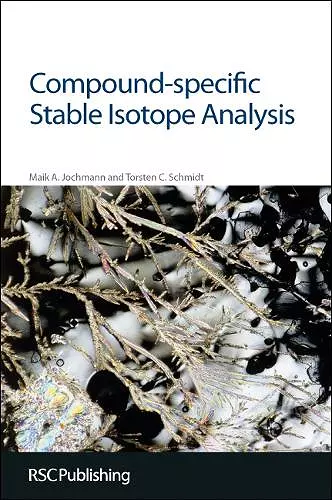Compound-specific Stable Isotope Analysis
Maik A Jochmann author Torsten C Schmidt author
Format:Hardback
Publisher:Royal Society of Chemistry
Published:29th Nov '12
Should be back in stock very soon

1. The first book to focus on compound-specific isotope analysis 2. Comprehensive coverage of calibration and referencing strategies 3. Includes exercises for students that could form the basis of a short course 4. Provides a broad overview of applications 5. Many examples of data presentation and interpretation
Compound-specific Stable Isotope Analysis (CSIA) is a technique that is increasingly used in many areas of science and technology for source allocation, authentication, and characterization of transformation reactions.
The use of Compound-specific Stable Isotope Analysis (CSIA) is increasing in many areas of science and technology for source allocation, authentication, and characterization of transformation reactions. Until now, there have been no textbooks available for students with an analytical chemical background or basic introductory books emphasising the instrumentation and theory. This book is the first to focus solely on stable isotope analysis of individual compounds in sometimes complex mixtures. It acts as both a lecture companion for students and a consultant for advanced scientists in fields including forensic and environmental science. The book starts with a brief history of the field before going on to explain stable isotopes from scratch. The different ways to express isotope abundances are introduced together with isotope effects and isotopic fractionation. A detailed account of the required technical equipment and general procedures for CSIA is provided. This includes sections on derivatization and the use of microextraction techniques in GC-IRMS. The very important topic of referencing and calibration in CSIA is clearly described. This differs from approaches used in quantitative analysis and is often difficult for the newcomer to comprehend. Examples of successful applications of CSIA in food authenticity, forensics, archaeology, doping control, environmental science, and extraterrestrial materials are included. Applications in isotope data treatment and presentation are also discussed and emphasis is placed on the general conclusions that can be drawn from the uses of CSIA. Further instrumental developments in the field are highlighted and selected experiments are introduced that may act as a basis for a short practical course at graduate level.
CSIA requires dedicated instrumentation, a lot of expert knowledge, and often years of hands-on experience. The textbook-like companion by Jochmann and Schmidt will
make this method more accessible and the book is a welcome promotion for a promising analytical tool.
The book is an excellent support for isotoperelated laboratory courses on MSc and PhD student level, where it will be used for practical advise as well as for background reading. Experienced researchers and science consultants will appreciate having this book on their shelves as a quick reference to a versatile and developing analytical technique.
* Anal Bioanal Chem 2013 Vol 405 27ISBN: 9781849731577
Dimensions: unknown
Weight: 732g
392 pages